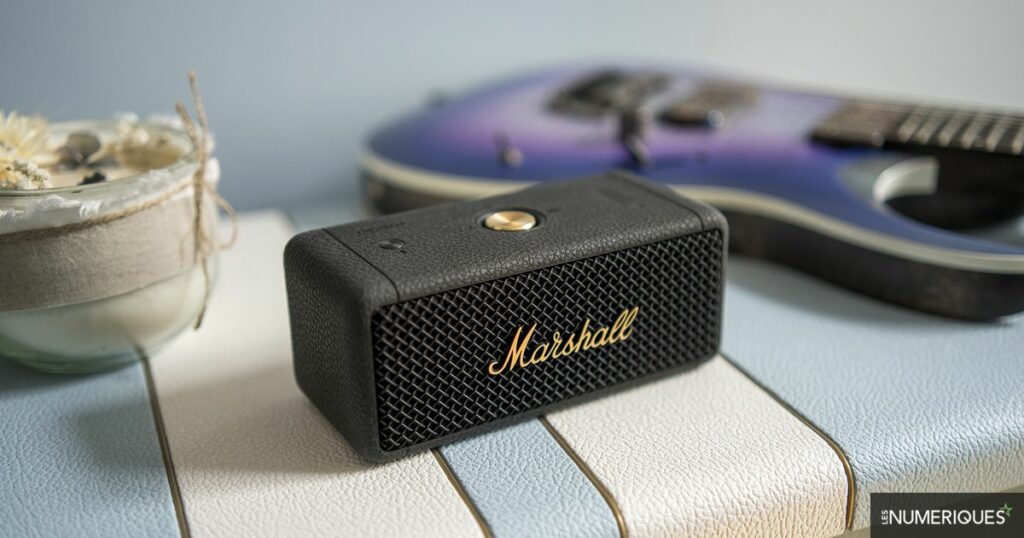Marshall synchronizes with the arrival of sunny days to draw two new Bluetooth speakers, including the Emberton II that we welcome as part of this test. Launched at €169 on May 3, 2022 (i.e. €20 more than the launch price of the first version), this second version largely takes up the specificities of the Emberton with a few additions relating mainly to the user experience of the speaker: support for the Marshall Bluetooth application, coupling of several similar speakers, autonomy of more than 30 hours and passage to IP67 certification are the main new features on paper.
At first glance, the difference between the two versions of the Emberton is not obvious: if we note very discreet aesthetic nuances, overall, the two portable speakers are made from the same mould. The rubberized non-slip surface, making it easier to grip the speaker and providing it with greater resistance to shocks and scratches, is still present, and it is still possible to detach it if necessary. The Emberton II still enjoys a very good quality of manufacture and a level of finish that is so to speak irreproachable, and is as robust and waterproof as its big sister. Nothing to say on this point.
The USB-C port is used exclusively to recharge the speaker: complete drying will obviously be required after immersion if you wish to use it.
On the connection side, no change has been made. It is therefore always necessary to be satisfied with the wireless connection via Bluetooth, the only means of listening to its contents, but one can in a certain way console oneself with the presence of the multipoint function, allowing two source devices to be connected simultaneously to the enclosure. There are nevertheless more things to put in their mouths in terms of functionalities… even if one should not expect too much. The Emberton II is indeed now supported by Marshall Bluetooth, an application that is certainly fluid, simple, but too succinct. This gives access to three equalization profiles, without any possibility of extensive customization, and facilitates the handling of the “Stack” function, now allowing several Emberton IIs to be coupled together (only to multiply the power, and only on the Emberton II). A display of the current reading and the battery level is also offered, but it stops there.
The interaction with the enclosure is always done without great complexity, once you have understood the operation of the joystick located on the upper surface and “tamed” the small latency which follows each interaction with the controls. This latency is also found to a certain extent depending on the source chosen, but benefits from sufficient compensation if you go through a mobile video streaming application.
Sound and light indications, some particularly explicit, are once again integrated to best support the user.
There is also a new side of autonomy. While its big sister was already generous with its 20 hours of use per charge at a relatively moderate listening volume, the Emberton II has the luxury of promising up to 30 hours of listening. In practice, we did not manage to reach this value under these conditions, but the loudspeaker nevertheless lasted more than around 22 hours, which is still an excellent result. It is possible to approach the 30 hours promised by remaining very wise on the listening volume, at a sufficient level for close listening indoors for example.
We were obviously expecting the Emberton II at the turn to correct the sound defects of the first version, but unfortunately it won’t be for this time. Marshall’s portable speaker retains the same sound architecture as its predecessor, namely two full-range loudspeaker + passive radiator pairs positioned respectively on the front and rear sides of the speaker (where the grilles are located).
The resulting listening experience is very similar between the two speakers, whether in terms of overall sound, directivity, distortion management or even stereophonic reproduction (always quite curious with this “True Stereophonic” design ), even if we feel that the manufacturer has made a slight adjustment in terms of frequency response.
Frequency response measurements: with « Marshall » listening profile (normal), Push profile (red), Voice (grey)
To synthesize, the Emberton II offers a relatively colorful reproduction, particularly oriented towards the upper part of the spectrum, and which therefore turns out to be lively, sharp and hard-hitting… but still lacks subtlety and softness. It can therefore sometimes be a bit aggressive at moderate volume (depending on the content listened to). The rendering gradually hardens and even becomes grueling when you push the enclosure to its limits. If the Emberton II offers deep bass and a nice base given its volume (even if they are a bit intrusive at times), it does however show a slight difference in processing between the bass and the midrange.
Harmonic Distortion Rate measurements: normalization to 79 dB SPL (red) and 83 dB SPL (purple). The Emberton II has a very nice reserve of power, unfortunately not very usable due to the rise in distortion, the crushing of the dynamics and the increasingly predominant aggressive sound (which is accompanied by the way a gradual bass decay).
The slight hollow at this border further reinforces the original “punchy” sound. On the power side, for the same reasons as those mentioned on the first of the name (namely the rise in distortion), the Emberton II will show its best face as long as we limit ourselves to 50/60% of the listening volume. , a sufficient reserve to listen to your music in a good-sized room, or nearby outdoors. Regarding the reproduction of the sound stage, it behaves almost identically to its predecessor: we therefore advise you to read the article dedicated to it if you want to know more.
Measurement of the frequency response (signal sent only on the left channel): measurement microphone in the axis of the enclosure (black), enclosure positioned at 45° (blue), at 90°.


